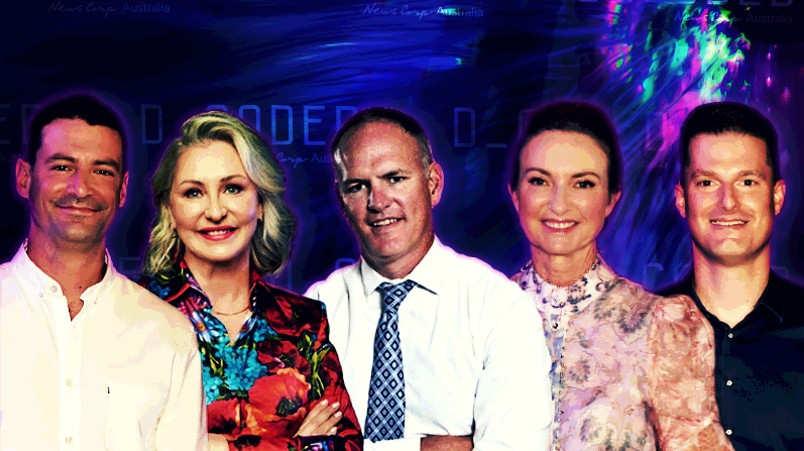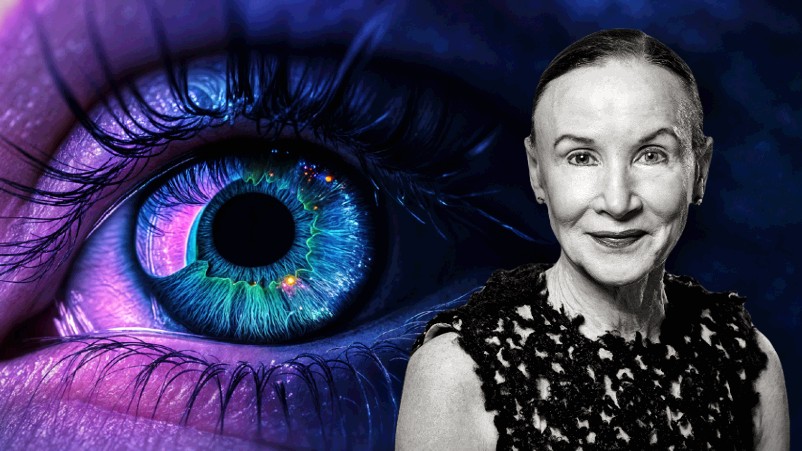News Corp closes gap on Nine in ‘Total Commerce’ rollout; inks Westpac DataX deal; AI to link consumer intent signals to ecom inside content, conversion rates jump 30%; revives troubled publisher short-form video to take-on BVOD

News Corp banks on "Total Commerce", AI for new revenues. L-R: Mark Brownie, Lou Barrett, Michael Miller, Pippa Leary and Paul Blackburn front the publisher's national D_Coded roadshow
News Corp landed some heavy hits this week at the start of its D_Coded national roadshow, building out its pledge over the past year to link audiences to ads and ecom transactions in a bustling “full funnel” suite of new data and tools it calls “Total Commerce”. The publisher has struggled to tap the market stampede to digital video formats but armed with new reach and audience engagement data from measurement firm Adgile, it wants a bite of the TV networks’ BVOD boom and social video with shoppable vertical video for its base of 75 million streams per month. The publisher said it had increased its investment in video tenfold this year. Buyers say the momentum is now with News, raising the pressure on Nine. But how all of this plays out under looming privacy changes is the question everyone now faces.
What you need to know:
-
News Corp has increased its investment in video tenfold this year, targeting BVOD, social and the $300m in ad revenue forecast to exit linear TV this year.
-
The publisher has started its national D_Coded roadshow in which “Total Commerce” is the flagship announcement – it has a new tech bundle aimed at “moving passive readers and viewers to active buyers,” per Pippa Leary, Managing Director, Client Product.
-
It is using AI to connect data from the likes of six million daily Westpac DataX transactions to model purchase intent and match users to products and services that can be purchased directly from retailers and brand DTC sites through its “headless commerce” tech – the key play is users do not leave News Corp’s content or sites during the transaction, resulting in a claimed 30 per cent higher shopping cart conversion rate.
-
News Corp said news.com.au was the number one referring domain to online retailers – driving $26.9 million in “directly attributable” sales.
-
The publisher is challenging marketing convention that brand building and direct response advertising are separate activities – “Marketing science suggests you shouldn’t aim for double duty in your communications, that it’s not possible – we’re giving it a red hot crack,” per Digital Revenue and Trading GM, Mark Brownie.
Nine still leads the market on integration across its media assets [but] News has definitely got momentum. There was a huge amount in there. It will take a while for people to digest, but it was a really strong narrative. It opens up different routes to market for a large number of our clients.
News Corp’s annual market roadshow showcasing its product and innovation plans was the strongest since launching D-Coded four years ago in a series of announcements headlined by a Total Commerce bundle using AI to link retailer and brand DTC ecom sites and catalogues to News Corp ads, content and a “headless commerce” purchase mechanism.
It allows audiences to complete a purchase transaction inside video or text content without being moved off platform to an ecom site and that piece of “frictionless” tech is lifting shopping cart conversion rates by at least 30 per cent – News Corp said its marquee pilot with Moet & Chandon delivered purchase conversions higher than its 30 per cent pledge but would not table the figure.
However, it disclosed the Moet & Chandon shoppable ad units hit “19,000 click-to-shop interactions” and increased foot traffic to Dan Murphy’s and Vintage Cellars by 37 per cent using Near geo-location user data matched to ad exposures across News Corp’s network.
In a direct punch to Google and Facebook – which frustrate advertisers on their hording of user data – News Corp said its commerce clients own the customer data flow from its sites to the purchase.
Marketing science suggests you shouldn't aim for double duty in your communications, that it's not possible to deliver top of funnel and bottom of funnel outcomes all in the same execution. We are giving it a red hot crack.
The success so far of its “full funnel” play from ads to transaction has sufficiently bolstered News Corp to challenge much of the marketing community’s view that longer term brand building and direct response, or performance advertising, are distinctly different exercises in marketing.
“Marketing science suggests you shouldn't aim for double duty in your communications, that it's not possible to deliver top of funnel and bottom of funnel outcomes all in the same execution. We are giving it a red hot crack,” per News Corp’s Digital Revenue and Trading boss Mark Brownie.
He also cited analysis from video measurement firm Adgile which breathed new life into short-form publisher video, long sidelined by most media buyers, which showed News Corp’s 75 million video streams each month across its publishing assets were 1.5 times more likely to drive a user to a website within an hour of exposure to an ad and 1.6 times more likely to drive a conversion than BVOD, a circa $450m category. He said 92 per cent of News Corp’s video audience did not watch BVOD, though TV networks will no doubt dispute that claim. “We are the great reach builder,” proclaimed Brownie.
Omnicom Media Group Chief Investment Officer Kristiaan Kroon said “we’d want to see the detail on the Adgile data” but noted News Corp was catching up on Nine, “which still leads the market on integration across its media assets. News has definitely got momentum,” he said. “There was a huge amount in there, it will take a while for people to digest, but it was a really strong narrative. It opens up different routes to market for a large number of our clients”.
News Corp’s Managing Director, National Advertising, Lou Barrett, told Mi3 the publisher was gunning for BVOD and the $300m-plus this year forecast to be pulled from linear TV advertising.
“We're bringing short-form video back on the agenda,” Barrett said. “It's been relegated to the background for the last couple of years in favour of long-form. Now we can prove that it has a better conversion rate so premium short form video should be a part of people's marketing strategy. Advertisers should take money out of social, out of BVOD and put it into premium News Corp video inventory,” was her no-nonsense suggestion.
When pressed, Barrett said she would be happy with one per cent of the $450m BVOD ad market, or circa $4.5m, in the next year. How far could it go? “Who knows when you’ve got effective outcomes you can prove,” she said.
‘Contextual commerce’
Shoppable vertical video was another initiative News Corp rolled out this week – 75 per cent of video consumption is on mobile and the publisher has created a social-like video unit which runs full screen and across its network allowing purchase transactions to be completed inside those editorial or advertising video units. In the case of lifestyle editorial content, for instance, these are linked to a relevant product or service via AI – meaning the “Total Commerce” pitch from News Corp could be equally be badged as ‘contextual commerce’.
“I think we're doing 75 million views on videos in TikTok for news.com.au so we know our right to play,” said Paul Blackburn, director of Commercial Data, Video and Product. “But we have invested in the technology to do it on our own platform, and for a specific vertical video player for the open web as opposed to an app. It means we can take advantage of [user] intent and data to both target advertising, inform content recommendations but also measure the outcomes of advertising.”
Blackburn claimed the set up presented a “great alternative to social” that means News can “lift the TikTok commercial messages and stick them into our vertical player dynamically. It's not going to be a strain on clients because they all have their social teams, they're all using those channels now. We're giving them a premium alternative [within] trusted content.”
Intent interceptor
Underpinning the new bundle of News Corp’s commerce and ad products is its ambition to “intercept intent” from its audiences using AI and data alliances including six million daily credit card transactions via Westpac DataX’s first commercial deal. The claim is that it can predict signals that users can be shifted from the top of the sales funnel – i.e. priming, awareness and consideration of a product or service – to a buy.
That tech set up is “aimed at doing one thing and that is moving passive readers and viewers to active buyers,” said Pippa Leary, National Managing Director, Client Product.
“We've zoomed in on all the parts of the purchase funnel and we think that we've built great tools at each of those steps to help us do that. We've got further to go but we know, for example, we've got 91 per cent of the adult population hitting news.com.au twice a week. How do we turn those people from being passively interested into anything our clients are selling into actively engaging with the content or going and visiting their sites or buying their products from within our content? The number one way we do that is to identify intent.”
As well as the Westpac DataX card transaction data and Near geo-location tracking, the newly rebadged Intent Connect insights unit, previously News Connect, bundles together another handful or consumer data alliances then harnesses AI to identify intent-to-purchase triggers. Crucially for advertisers it is forward looking, per Paul Blackburn.
“Intent Connect leverages our increased investment in data science to move from targeting past behaviours to modelling out and predicting future intent,” he said.
“So today you can buy next week's customers who are going to buy that lipstick on vogue.com.au or at their favourite retailer. We're moving from predefined or homogeneous segments like tribes or cohorts to the unlimited layering of any combination from our 5,000-plus real time audience segments,” added Blackburn.
“We're moving from it being about News Corp publishing assets to providing Intent Connect capability across Foxtel, Binge, Kayo, REA and Medium Rare. It allows our clients a single data activation and view for a campaign across our combined assets and sales teams. We're evolving our data partnerships with a focus on understanding SKU (stock keeping unit) level purchase data at the impression level.”
Retailers such as Coles and Woolworths building out major media businesses are trying to do exactly the same thing – but coming from the opposite direction. Which could prove for an interesting front line as the two sides start to meet in the middle.
[News Corp's new tech stack is] aimed at doing one thing – and that is moving passive readers and viewers to active buyers.
Lipstick effect
Like the lipstick example, Leary said News Corp is moving to an “affiliate marketing 2.0” plan which models user purchase intent from its data alliances in a given period for cars, travel, finance and beyond. It is then using machine learning models to match those data “signals” to contextual editorial content and retailer catalogues ingested into News Corp’s system in real time.
“So I might be reading a story in Body and Soul on fitness regimes and weightlifting,” said Leary. “The algorithm will pick up that we have a client that sells activewear, so it will just create a widget either down the side or underneath an article, it will collect information from either one client or all of our clients and do a price scan and so people who are reading the article will be able to see the product that's being referred to down the side of the page. The beauty of it is that human hands don't touch this. This is done by machine learning,” said Leary. “So it allows us to scale. Lots of people are out there claiming ‘we're becoming a shop front’ but this is going to allow us to scale deeply into a lot of our content. That's the real key for us.”
Affiliate pay dirt
Leary said News Corp’s affiliate marketing initiative was sending “hundred of thousands of clicks and referrals” to retail partners annually. “News.com.au is now the number one referring domain to online retail in Australia,” she claimed. “It delivered $25.9 million directly attributable online sales for our partners in 2022 alone.”
In the annual industry-wide cyber weekend sales event each November, Leary said News Corp’s ecom team created 70 articles across 13 websites highlighting the “best the retail industry had to offer” which resulted in 1.4 million clicks of “high intent” shoppers directly to retailer ecom sites with $9 million in “directly attributable sales”. But she said with its shoppable video text ad and editorial units, which plug directly into at least six different ecom platforms like Shopify, BigCommerce and the Salesforce and Adobe tech stacks, News Corp no longer has to send its audiences off site to purchase – and has lifted conversion rates 30 per cent.
The net effect, claimed Leary, is that “it evolves our role to an integrated shop front”.
News Corp Executive Chairman Michael Miller acknowledged the new bundle of products had “been a number of years in the making” but the publisher was figuring out how to better monetise its primary product – content. "Content is driving those consumer behaviours,” he told Mi3. “It's the ‘Top Tens’, it's the most favoured, it's all of that in a contextual environment of holidays and travel, kids products on taste.com.au, we're reviewing kitchen products and so-on. That's where the context is and what I feel we've really improved at over the past couple of years.”
The only challenge to News Corp’s contextual commerce vision will be where the Federal Attorney General lands on its new privacy rules – much of what the publisher is doing, and most of its media rivals and platforms are doing, will likely require consumer consent on tracking and the trading of their data, even if de-identified. Game on.


